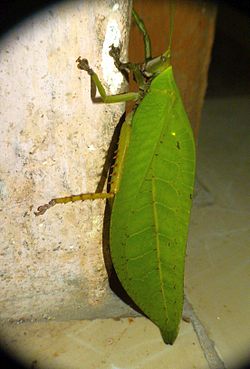There are many insects in the family Tettigoniidae (bush crickets or katydids) which are mimics of leaves. [1] At a distance the katydid is an example of crypsis evading detection by blending into its background; up close the katydid mimics a leaf. [2]
This type of camouflage occurs in several subfamilies, among others including:
Other unrelated insects adopting a similar camouflage strategy include the leaf insects.
- Typophyllum laciniosum, Tambopata File:National Reserve, Peru
- Aegimia elongata
- Pycnopalpa bicordata, Trinidad
- Onomarchus kanara



